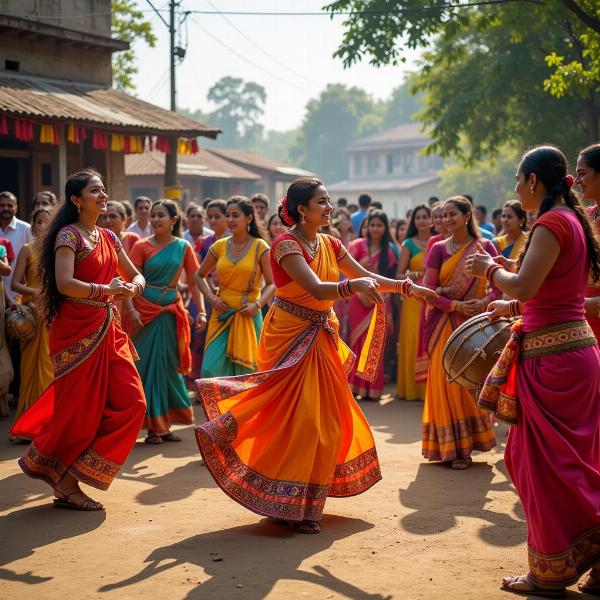Folk dance, or lok nritya (लोक नृत्य) in Hindi, is a vibrant expression of India’s rich cultural heritage. It’s more than just rhythmic movement; it’s a storytelling medium, a celebration of life, and a powerful symbol of community bonding. Understanding the meaning of folk dance in Hindi goes beyond a simple translation – it’s about appreciating the deep-rooted traditions, the regional variations, and the emotional resonance these dances hold within Indian society.
Exploring the Richness of Lok Nritya
The term lok (लोक) means “people” or “folk,” while nritya (नृत्य) signifies “dance.” Together, they encapsulate the essence of dances that have evolved organically within communities, passed down through generations. These dances are often associated with specific regions, festivals, rituals, or occupations, reflecting the diversity of Indian life. Lok nritya isn’t confined to professional performers; it’s a participatory art form, engaging people of all ages and social backgrounds.
 Indian Folk Dance Celebration
Indian Folk Dance Celebration
What makes lok nritya so compelling is its connection to the everyday lives of people. Whether it’s a harvest dance celebrating a bountiful yield, a ritualistic dance seeking divine blessings, or a social dance marking a special occasion, lok nritya reflects the hopes, fears, joys, and sorrows of the community.
Regional Variations and Cultural Significance
From the energetic Bhangra of Punjab to the graceful Garba of Gujarat and the mesmerizing Kathakali of Kerala, India boasts a dazzling array of folk dance forms. Each region has its own unique style, costumes, music, and storytelling traditions. These variations reflect the geographical, historical, and social influences that have shaped the cultural identity of each region.
For instance, the Bihu dance of Assam, performed during the harvest festival, celebrates the agricultural cycle and the close relationship between humans and nature. In contrast, the Chhau dance of Jharkhand, Odisha, and West Bengal, often performed by masked dancers, narrates mythological stories and epic battles.
Folk Dance: More Than Just Entertainment
Lok nritya transcends mere entertainment. It serves as a powerful tool for social cohesion, bringing communities together in shared celebration and ritual. It also plays a crucial role in preserving cultural heritage, transmitting traditions, values, and stories from one generation to the next. The vibrant costumes, rhythmic music, and expressive movements create a captivating spectacle, while the underlying narratives often carry profound social and spiritual messages.
What is the Significance of Folk Dance in Indian Culture?
Folk dances are deeply intertwined with Indian culture, acting as a vibrant expression of traditions, values, and social bonds. They are not simply performances but integral parts of celebrations, rituals, and everyday life, reflecting the diversity and richness of India’s cultural tapestry.
What are Some Popular Folk Dances of India?
India boasts a multitude of folk dances, with some of the most popular including Bhangra from Punjab, Garba from Gujarat, Dandiya Raas also from Gujarat, Bihu from Assam, Kathakali from Kerala, and Chhau from Jharkhand, Odisha, and West Bengal. Each dance form carries its unique charm and cultural significance.
How is Folk Dance Preserved and Passed Down Through Generations?
Folk dances are primarily preserved and transmitted orally within communities, passed down from elders to younger generations through direct instruction and participation. In recent times, efforts have been made to document and promote these dances through academic research, cultural programs, and festivals, ensuring their continued vitality.
Conclusion: Embracing the Legacy of Lok Nritya
Folk dance, or lok nritya, is an integral part of India’s cultural identity. It’s a vibrant tapestry woven with threads of tradition, storytelling, and community bonding. Understanding its meaning in Hindi is about appreciating the profound role it plays in shaping Indian society and preserving its rich cultural heritage. From joyous celebrations to solemn rituals, lok nritya continues to resonate deeply within the hearts of Indians, connecting them to their roots and expressing the essence of their cultural identity.
FAQs
-
What does “lok nritya” literally mean? It means “folk dance,” with “lok” referring to people or folk and “nritya” meaning dance.
-
Why are folk dances important? They preserve cultural heritage, foster community bonding, and provide entertainment rooted in tradition.
-
How are folk dances different from classical dances? Folk dances are more informal, often participatory, and reflect regional variations, while classical dances are more structured and follow specific rules.
-
Are there any folk dances associated with specific festivals? Yes, many folk dances are associated with festivals like Bihu (Assam), Garba (Gujarat), and Onam (Kerala).
-
Where can I learn more about Indian folk dances? You can explore online resources, cultural centers, and attend folk dance performances to deepen your understanding.
-
How can I contribute to preserving folk dance traditions? Supporting local artists, participating in community events, and learning about these dances are valuable ways to contribute.
-
What role does music play in folk dances? Music is essential, providing the rhythm and emotional context for the dances, often played on traditional instruments.
Meaning-Hindi.in is your one-stop solution for all your Hindi translation needs. We specialize in a wide array of translation services, including business and commercial documents, legal and certified translations, technical manuals, website localization, educational and academic materials, and express translation services. Our team of expert translators ensures accurate and culturally sensitive translations that meet the highest quality standards. Contact us today for your Hindi translation requirements: Email: [email protected], Phone: +91 11-4502-7584. Meaning-Hindi.in is committed to bridging the language gap and connecting cultures.